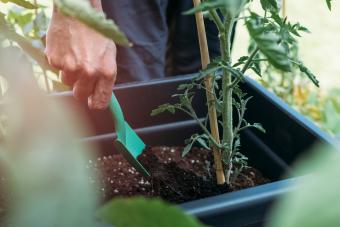
Gardeners understand it's important to know what is in gardening fertilizers and how these ingredients affect plants. Fertilizers can be made from organic materials or inorganic materials, whether manufactured using chemicals or obtained from the earth, like some minerals. Both can work equally well in the garden.
Composition of Organic Fertilizers

Organic fertilizers are made from plant material and considered superior to inorganic fertilizers. Organic fertilizers are slow-release that follow the rhythm of nature. They condition the soil, add texture and improve the health of plants by adding nutrients. They also encourage beneficial microbes to proliferate, resulting in healthier root development and overall stronger plants.
Compost
Compost is made from decomposed plants. Grass clippings, leaves raked from the lawn, apple peels, and any discarded uncooked fruit or vegetable peels or cores can be added to a compost pile. It's difficult to overdose plants on compost. In fact, most gardeners would say that the more compost used, the better.
- Some people add shredded newspaper, tea bags, eggshells and coffee grounds.
- Meat scraps should never be added to compost piles since they smell bad, attract vermin and slow down the composting process.
- Some home gardeners use bins or compost tumblers while others simply use an open pile of organic debris.
- Materials added to the compost pile will decompose thanks to the action of various microbes and heat generated.
- The final result is a rich, crumbly material often dubbed black gold by gardeners.
Peat Moss
Gardeners often add peat moss to the soil to improve soil texture and add nutrients. Peat moss is harvested from peat bogs where decomposing moss creates thick mats. It's then dried and sold by the bag or container for home use.
- Peat moss is valuable to plants, such as blueberries since it has an acid pH.
- It aids the soil in retaining moisture.
- As a soil amendment, peat moss will last for many years.
Seaweed or Kelp
Seaweed and kelp fertilizers are harvested plants that grow in the ocean. These plants are nutrient-rich and decompose rapidly. You can buy seaweed fertilizers at many garden centers or online.
- The best way to use seaweed or kelp fertilizers is in liquid form. Diluted with water, it is sprayed directly onto the foliage for better and faster plant absorption (8 to 20 times more effective than soil application).
- Unlike other fertilizers, you can vary the concentration of the seaweed/kelp according to plants. For example, a heavy nitrogen eater like corn may require a stronger concentration than green beans that naturally produce nitrogen in the soil.
- Seaweed trace elements include, nitrogen, magnesium, iron, potassium, and zinc.
Manures
Animal manure, such as cow and horse are natural organic fertilizers and are often added to gardens.
- When mixing manure into garden soil, allow the manure to age before setting plants. Otherwise the manure will burn the plant's roots.
- The best time to add manure to garden soil is in the fall so it has several months to age.
- Mix manure with compost to dress plants and avoid possible root damage.
Inorganic Fertilizer Nutrients

Inorganic fertilizers are composed of ground up rocks, such as limestone and rock phosphate or manufactured chemical fertilizers. Inorganic fertilizers can be quick or slow release. Chemical fertilizers may be grouped into two types, fertilizers suitable for home garden use and mass produced agricultural fertilizers. The nutrients are typically:
- Nitrogen is the key player of amino acids that produce proteins, so the plant can grow.
- Potassium is responsible for the plant's growth. Its value is only second to nitrogen.
- Sulfur allows plants to utilize nitrogen.
- Phosphorus feeds the plant root system and without it, plant growth will be stunted.
Using Home Garden Fertilizers
For home garden inorganic fertilizers, be sure to read the package labels to select a fertilizer ratio appropriate for your particular plants and garden.
- Most home garden inorganic fertilizers contain a balanced ratio of nitrogen, phosphorus and potash (potassium) expressed as a ratio of 10-10-10 or 20-20-20.
- You can find other fertilizers with more phosphorus that encourages blooming, such as a 5-10-5 fertilizer.
- Home garden fertilizers are typically granular or pellet forms that you sprinkle near the roots of plants.
- Lawn fertilizers placed in lawn spreader hoppers are gently spread across the yard.
Using Agricultural Fertilizer
Mass produced agricultural fertilizers are typically heavy in one or two macro nutrients, such as nitrogen and phosphorus. These are intended to spur plants on to immediate, heavy growth. Unfortunately, such fertilizers don't replenish the soil very well and when used for long periods of time can damage the soil which then produces weak crops, requiring heavier doses of fertilizer.
Slow-Release Fertilizer Ingredients
Slow-release fertilizers contain the same major nutrients as other fertilizers, such as nitrogen, phosphorus, potassium, sulfur, etc., but continuously feed the plant. They are often made using water-insoluble nitrogen (WIN) or a special coating to control their release. Nutrients are released slowly after each watering and are activated by heat. These fertilizers are either granular or dry blend formulas and the rate of release is determined by how soluble they are, weather conditions, and soil type.
Using Fertilizer
It's critical to read package labels and understand the proper type of fertilizer for your flowers, vegetables, trees, shrubs, houseplants and lawn. The safest fertilizers to use are organic fertilizers.







